

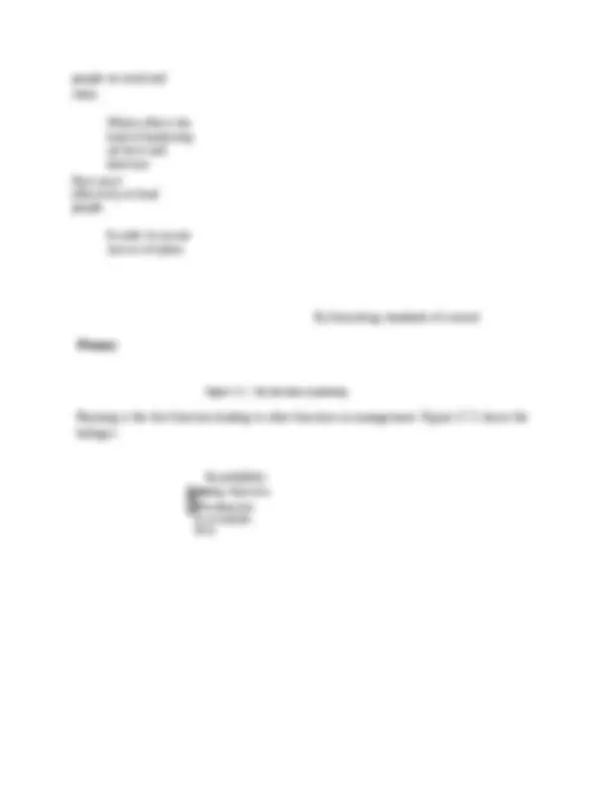
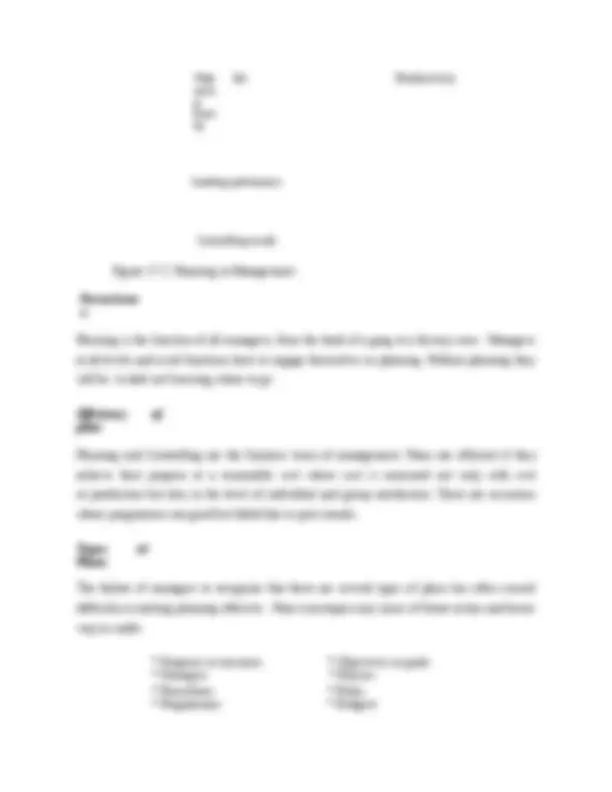
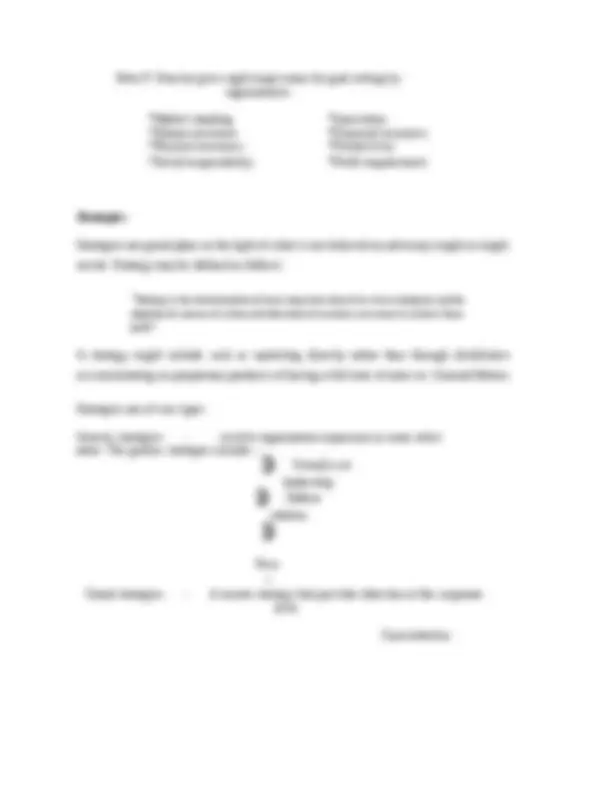



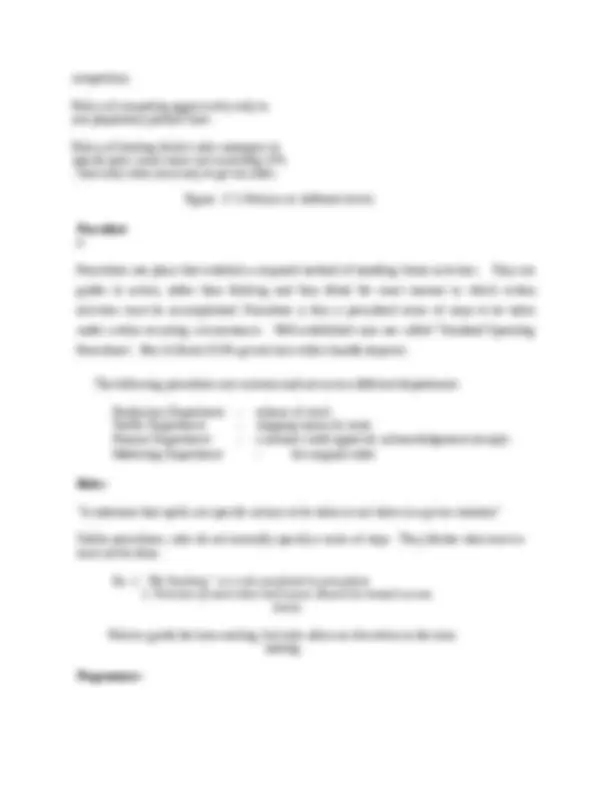

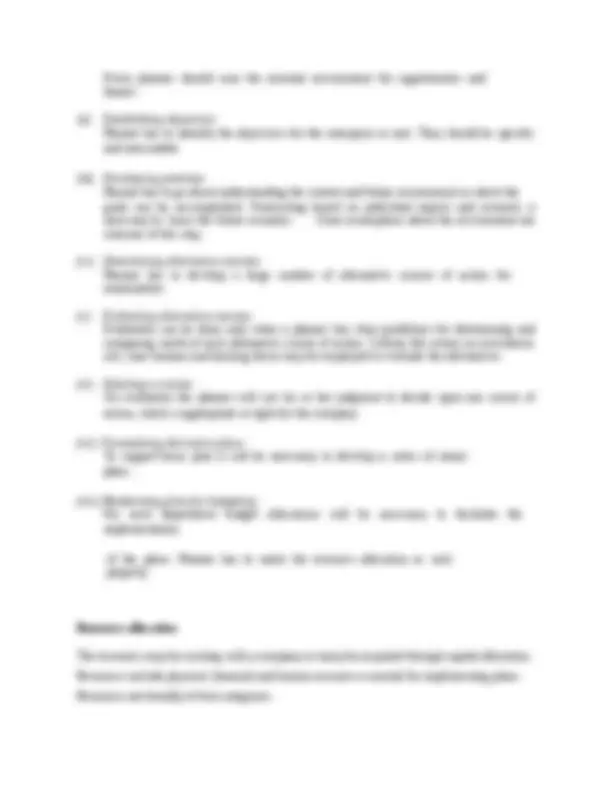

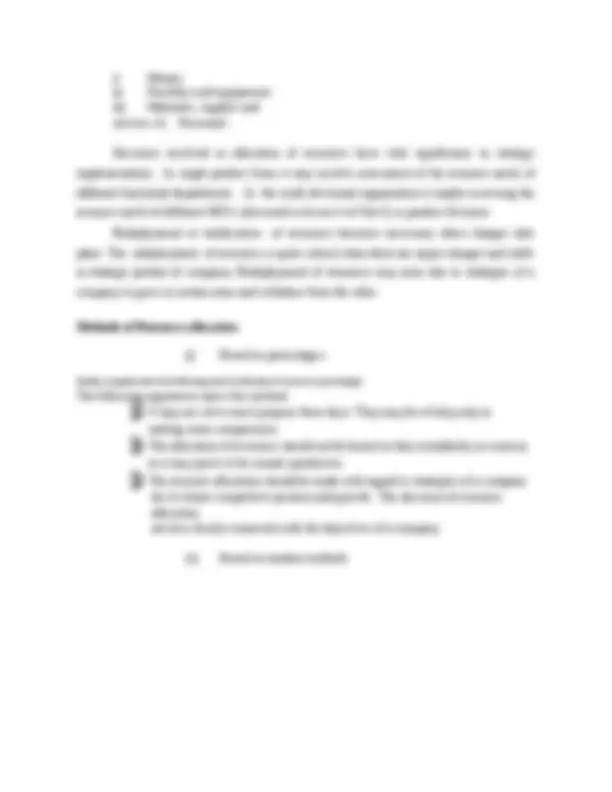

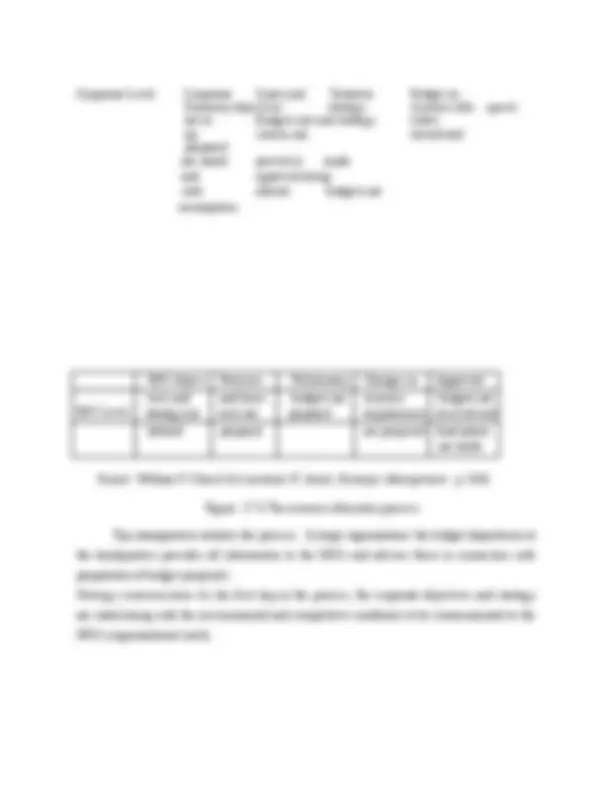
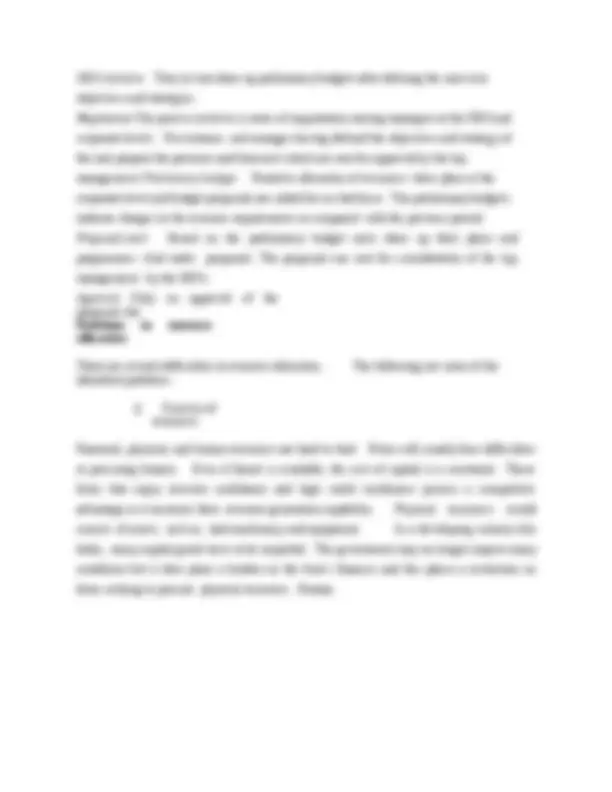
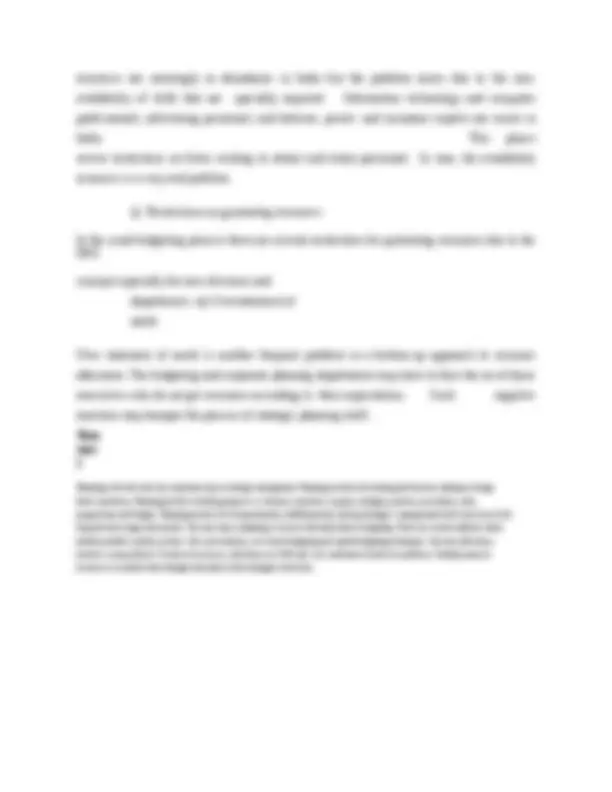


Study with the several resources on Docsity

Earn points by helping other students or get them with a premium plan


Prepare for your exams
Study with the several resources on Docsity

Earn points to download
Earn points by helping other students or get them with a premium plan
Community
Ask the community for help and clear up your study doubts
Discover the best universities in your country according to Docsity users
Free resources
Download our free guides on studying techniques, anxiety management strategies, and thesis advice from Docsity tutors
The importance of resource allocation in the planning process of organizations. It explains how planning is a futuristic, decision-oriented, and goal-driven function that helps organizations identify their objectives, decide on the necessary people and leadership styles, and set up various types of plans. The document also covers the challenges of resource allocation, including scarcity and restrictions on generating resources, and the methods of resource allocation. It concludes by discussing the role of budgeting in implementing plans.
Typology: Study notes
1 / 24

This page cannot be seen from the preview
Don't miss anything!

















Introducti on
While planning is the first step in formulating strategies resource allocation in the creative process of allocating resources into competences that could be used to garner competitive advantages. C.K. Prahlad and Hamel see resource allocation in an organization as a portfolio of resources and competences. Strategic managers have to take adequate care in identifying the resource allocation needs and make right allocations.
Planning – defined:
Planning is a way of organizational life. Planning is futuristic, decision oriented and goal driven. It is the first function of management and is the foundation for other functions like organizing and controlling. Here are some definitions on planning “Planning bridges the gap from where we are to where we want to go.^ It makes it possible for things to occur that would not otherwise happen”. “Planning involves selecting missions and objectives and achieve them; it requires decision making.”
BHEL used Delphi technique to explore future direction of power development. Firstly, it canvassed an open ended questionnaire to the engineers in several plants to give ideas for technological breakthrough for 30 to 40 years. In the second round these were summarized and asked to be prioritized. In the third round the estimated timings and rationale for forecast was asked. This helped BHEL not only to get 19 different forms of energy sources but also provided “refined guest mates”. The results were helpful in corporate planning and for formulating R & D projects.
Coke used a similar technique and conducted tests studies 30 cities in US to develop ‘diet coke’.
Nature of Planning:
There are four major aspects here. (i) Its contribution to purpose and objectives; (ii) Its primacy among the manager’s tasks; (iii) Its pervasiveness, and (iv) The efficiency of resulting plans
Contri bution Planning precedes all the other managerial functions. It involves setting up objectives necessary for all group efforts. Every executive should plan about recruitment, structure and controls. Figure 17.1 show the kind of contribution planning makes.
What kind of organisation structure to have
Which helps us know
people we need and when
Which effects the kind of leadership we have and direction How most effectively to lead people
In order to ensure success of plans
Primacy
By furnishing standards of control
Figure 17.1. Key decisions in planning Planning is the first function leading to other functions in management. Figure 17-2 shows the linkages.
F 0 B 7Setting Objectives F 0B 7 Deciding how to accomplish them
Orga nizin g- teami ng
for Productivity
Leading- performance
Controlling -results
Figure 17.2: Planning in Management. Pervasivene ss
Planning is the function of all managers; from the head of a gang to a factory crew. Managers at all levels and in all functions have to engage themselves in planning. Without planning they will be in dark not knowing where to go.
Efficiency of plans
Planning and Controlling are the Siamese twins of management. Plans are efficient if they achieve their purpose at a reasonable cost where cost is measured not only with cost or production but also in the level of individual and group satisfaction. There are occasions where programmes are good but failed due to poor morals.
Types of Plans:
The failure of managers to recognize that there are several types of plans has often caused difficulty in making planning effective. Plans encompass any cause of future action and hence vary as under.
Production department Producing 22 units per day Marketing department Selling 25 units per day Personnel department Training 200managers in the first quarter. Finance department Invest Rs. 200 crores with 32% return on investment in the current year. Goals serve many purposes like the following
Type of plans Type of goals Description Time range
Management level
Focus o f plans
Strategic plans Strategic goals Broadly defined targets or future end results set up by to p management
5 years Top management
Organization level
Tactical plans Tactical goals Future end results set up by middle management for specific departments o r units
1-5 years Middle management
Department level
Operational plans
Operational goals
Set by lower management that addres s measurable outcomes required from the lower levels
One year Lower management
Unit/group/level individual
Peter F. Drucker gives eight major areas for goal setting by organizations. *Market standing *Innovation *Human resources *Financial resources *Physical resources *Productivity *Social responsibility *Profit requirements
Strategies:
Strategies are grand plans in the light of what it was believed an adversary might or might not do. Strategy may be defined as follows.
“Strategy is the determination of basic long term objectives of an enterprise and the adoption of courses of action and allocation of resources necessary to achieve these goals”. A strategy might include such as marketing directly rather than through distributors or concentrating on proprietary products of having a full time of autos ex: General Motors.
Strategies are of two types: Generic strategies - involve organization expansion in some select areas. The generic strategies include – F 0B 7 Overall cost leadership F 0B 7 Differe ntiation F 0B 7
Focu s Grand strategies - A master strategy that provides direction at the corporate level Concentration
Diversification
Grand strategies
Policies:
Stability strategy
Defensive strategy
Harv
est
Turnarou nd
Divestitu re Bankrupt cy Liquidati on
Policies are plans or general statements or understandings that guide or channel thinking in decision making. Policies define an area in which decision is to be made and ensure consistency to objectives. Policies help managers maintain control and delegate authority.
Policies exist at all levels in an organization. They may be major or minor. Policies include hiring trained engineers, encouraging employee suggestions, confirming to high standards, setting competitive prices, cost plus pricing etc. Companies can have policy manuals which may stipulate non-acceptance of gifts from suppliers, favours of entertainment or seek outside employment.
Making policies is difficult for F 0B 7 They are seldom defined in writing F 0B 7 Delegation of authority will create confusion F 0B 7 Actual policy may be difficult to ascertain and intended policy may not be clear.
Policies are necessary at different hierarchical levels as shown in Figure 17- Pr es id
Vice-president sales
Regional sales manager
District sales manager
Company policy of aggressive price
competition
Policy of competing aggressively only in non proprietary product lines
Policy of limiting district sales managers to special price concessions not exceeding 10%
Figure 17.4 Policies at different levels Procedure s: Procedures are plans that establish a required method of handling future activities. They are guides to action, rather than thinking and they detail the exact manner in which certain activities must be accomplished. Procedure is thus a prescribed series of steps to be taken under certain recurring circumstances. Well-established ones are called ‘Standard Operating Procedures’. Ex: In Banks SOPs govern how tellers handle deposits.
The following procedures are common and are across different departments. Production Department - release of stock Traffic Department - shipping means & route Finance Department - customer credit approval, acknowledgement receipts Marketing Department - for original order Rules: “A statement that spells out specific actions to be taken or not taken in a given situation” Unlike procedures, rules do not normally specify a series of steps. They dictate what must or must not be done. Ex: 1. “No Smoking” is a rule unrelated to procedure.
2. Fraction of more than half ounce should be treated as one ounce. Policies guide decision making, but rules allow no discretion in decision making. Programmes:
Examples of programmes are :
1. A major airline acquiring $400 million fleet of _jets
Making programmes include six steps:
i) Dividing the project into parts ii) Determining relationships and pulling in a sequence iii) Deciding responsibilities for mangers iv) Determining how to complete and what resources are necessary v) Estimating time requirements vi) Developing a schedule of implementation
A primary programme may trigger off a series of small programmes.
Budgets:
Budget is a numberized programme. It can be defined as follows. “Budget is a statement of expected results expressed in numerical terms” Budget can be expressed in financial terms, labour hours, units, machine hours etc. It may show expenses, capital outlays, cash flowsetc.
A budget is a fundamental planning instrument. Budget forces precision in planning. F 0B 7
F 0B 7
Flexible/variable budgets Programme budgets
them and give cost estimates. F 0B 7 Operating budget - A finance plan for each responsibility during budget period. F 0B 7 Capital budget - Budget for Mergers & Acquisitions, divestiture of fixed assets
Steps in planning
Planning is a step by step process. It involves the following
steps. (i) Being aware of opportunities :
i) Money ii) Facilities and equipments iii) Materials, supplies and services iv) Personnel Decisions involved in allocation of resources have vital significance in strategy implementation. In single product firms it may involve assessment of the resource needs of different functional departments. In the multi divisional organization it implies assessing the resource needs of different SBUs (discussed in lesson 4 of Unit I) or product divisions Redeployment or reallocation of resources becomes necessary when changes take place. The redeployment of resources is quite critical when there are major changes and shifts in strategic posture of company. Redeployment of resources may arise due to strategies of a company to grow in certain areas and withdraw from the other.
Methods of Resource allocation
(i) Based on percentages:
Usually, companies have been following system of allocation of resources by percentages. The following arguments reject this method. F 06 F It may not serve much purpose these days. They may be of help only in making some comparisons. F 06 F The allocation of resources should not be based on their availability or scarcity as it may prove to be counter productive. F 06 F The resource allocation should be made with regard to strategies of a company for its future competitive position and growth. The decisions of resource allocation are also closely connected with the objectives of a company. (ii) Based on modern methods